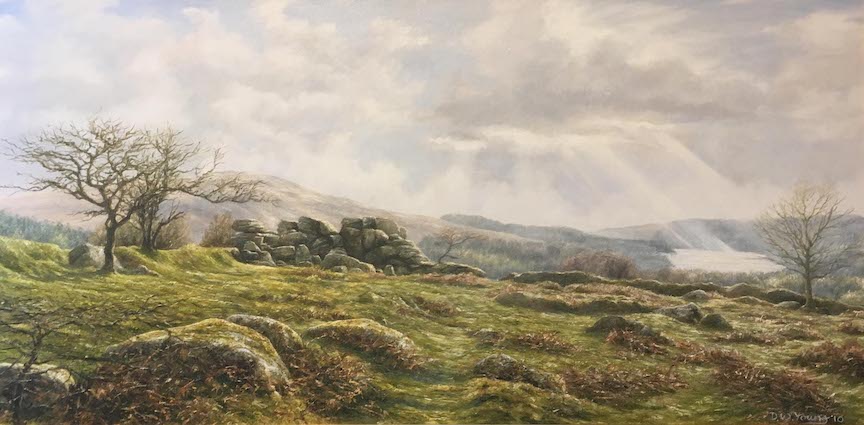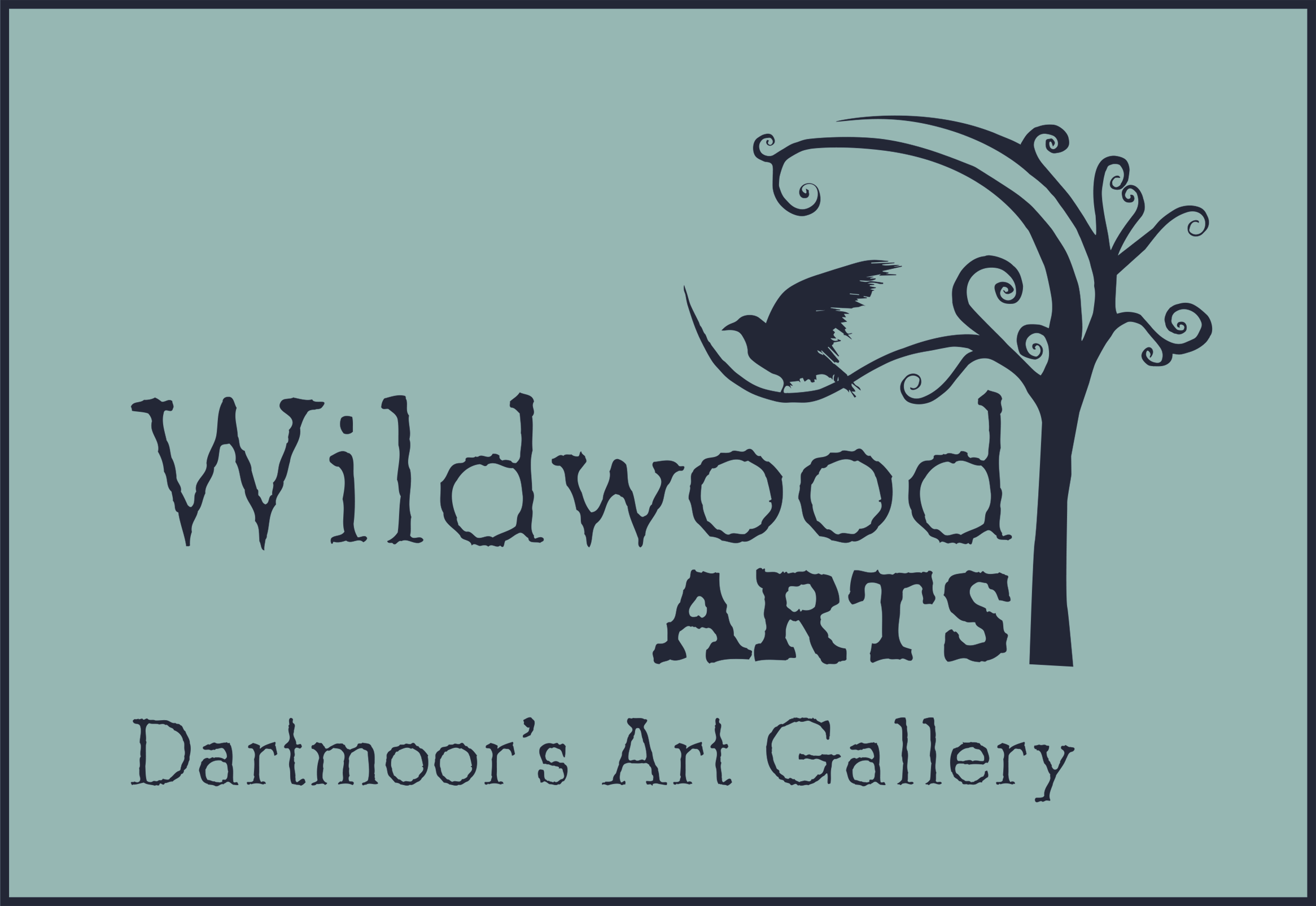
An interesting, wonderful walk and interview with artist David William Young, on Friday evening. We meandered along the lane towards Cuckoo Rock at Burrator, David picking various leaves to munch on. The countryside is a larder to David. He has vast knowledge of wild foraging and grows most of his own food too. I have to admit that the wild strawberries looked quite appealing, but I have tried the navelwort before and it made me breathless. David tells me he has recently bought three different species of hawthorn for his garden as our Dartmoor hawthorn tastes quite bitter. He had heard that these other species are rather different and tasty.
We stopped to admire a graceful and feminine ash tree which looked as though it was about to start dancing.

A mist tumbled down and around Sheep’s Tor, but it didn’t phase either of us. It just added to the atmosphere.

We turned up towards Down Tor and up onto the moor whilst discussing painting the different greens nature offers. The cuckoo’s call accompanying us all the way to Down Tor and Cuckoo Rock. There were skylarks soaring above, filling the sky with their song. We were scolded by stonechats while the crows and ponies argued between themselves . I asked David how he paints the landscape and his process.
“I have to visit a place and feel it,” said David. I take notes. I sketch it. I photograph it, but most of all I have to feel it. I have to take it all in through my different senses and then articulate that on the canvas through the paint.”
As we make our way to Down Tor, I spot a wheatear. ‘It’s a female!’ David tells me. She doesn’t fly off and we wonder why, until she turns and we see she has food in her beak.
“It’s a dull day today, but even so, these colours though shout out to me. I can see those colours and know how they are done and how to represent them. Then you start adding texture to it all and that’s really beautiful. Then there’s that affect of shadow and light and shimmering light, then you start putting all these things together. “People can say, he’s done a painting and it’s just like a photograph! It’s not like a photograph because if you know what I have put into that painting… but of course the public don’t really see that.”
I completely agree. Most people don’t know what goes into becoming an artist and creating a painting, which is exactly why I am doing this blog.
“I have worked so hard in my paintings to get colour, light and texture,” David tells me.
“I Experiment with broken brushes to apply paint in a certain way to create texture in order to capture a certain species of tree and their leaf patterns. The way you pick the paint up and apply it is so important and how it works with the tooth of the canvas and the colour and texture of the previous layer that have gone on to it. Often you put a layer on and it dries then it has a certain patina to it.Then you drag another layer over it and often it is chance- you can’t fully control everything the brush does, you direct it the best you can.”
We walk along the ridge of the hill. Down Tor is behind us and we see Higher Hartor Tor on the horizon. To our right the moor drops down and on the other side of the valley is Crazywell Pool. We traverse across the dried grasses until the cairn is visible and the stone row lines the back of the ridge and disapears into the distance. It is an arresting sight. It is Down Tor circle, also known as the Hingston Hill circle
Kingston Hill Circle is a megalithic feature on Dartmoor. It is a ring-cairn attached to a 349m (1145-foot) stone row that is concave as it dips downward and then rises upward with the terrain as it approaches the circle. The ruined cairn within the 11m (36-foot) diameter ring is some 8.5m (28 feet) across. There are twenty-five small stones forming the circle, averaging 0.5m (1 foot 7 inches) in height.’
https://www.megalithic.co.uk/article.php?sid=541
I ask for David’s view on what stone rows are and what they were for? He is hesitant. He thinks there are so many possibilities and we can never really know, but they are usually high and perhaps they were meeting places, or ceremonial? This area was heavily populated during the Bronze Age. The cairn maybe a burial of someone important he muses.

He shows me where he sat to paint the row. It is not the traditional view of the stone row which takes in all of the many stones disappearing into the distance. It focuses on just a side view of the main stones and the cairn. The largest stone is tall and the next short and thicker. He feels they could represent the male and female. I can see exactly what he means.

We discuss how the fact they are near the cairn might suggest the story of birth and death. In David’s painting, he painted a naked pregnant woman bent over between the two standing stones which hints at this birth and death and grief cycle. The figure shows reverence, piety, an offering and regeneration- a continuation of the feminine fertility.
He had wanted a model to pose, but instead ended up using artist’s books on anatomy for reference to create what he imagined. He had sat for hours on this spot, sketching, note taking, photographing and most importantly feeling the place and that influenced how he portrayed it. It was a different time of year than now. The landscape more autumnal. There is a curlew in the distance to the right and David explains it is symbolic of the moor. It has declined dramatically in recent years. In this painting it also represents departing spirits.
You can see from David’s painting his eye for detail, emphasising and drawing out what is important to him. This is what a great artists does. It isn’t just like a photograph of a place. It is an intimate relationship, an understanding of a place as well as a narrative or implied story, and a great artist such as David can masterfully articulate that through his composition, mark making, colour choices and use of paint.

Requiem Aeternam translates to “eternal rest” in Latin and is the title of David’s work.
The painting is currently on loan, but it is not for sale. It has a deep meaning for David. I think it connects to his affinity with this landscape and his sense of belonging to this land. “More and more people seem to be distancing themselves from nature”, David tells me. During the Bronze Age mankind relied on nature. For David, life becomes meaningless when we aren’t connected to the land.
I feel I am at least I am in contact with the real living world. To me that is so important. I have to have that contact. I have to have that exposure to the downs as well as the ups.
We walk back now and towards DownTor, dodging the boulders as we descend. There is a great view from the bottom which overlooks Burrator Reservoir. This is the spot from where David painted ‘Burrator Panorama’ pictured below.There is Sheep’s Tor to the left. David has captured the panorama perfectly. The light is streaming through the clouds and hitting the water of the reservoir. This is not a photograph. This is years of an exceptional artist honing his skills, connecting to this landscape, understanding this landscape, and having the mastery to beautifully articulate what it means to him and then sharing it with us the lucky viewer.

Prints available from Wildwood arts

With enormous thanks to David William Young. It was an absolute pleasure to walk with you.

